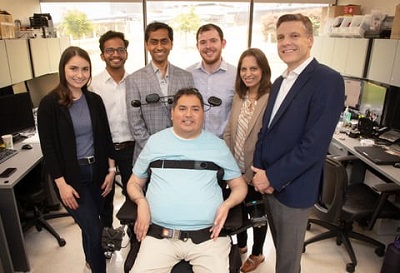New York, (Asian independent) In a first, US doctors, including those of Indian-origin, used brain implants and Artificial Intelligence (AI) to restore sense of touch and movement in a quadriplegic man — a person affected by paralysis of all four limbs.
Keith Thomas, 45, was left paralysed from the chest down, making him unable to move and feel, after a diving accident in 2020.
After being in a hospital for more than six months, he decided to be part of a novel clinical trial at Northwell Health’s Feinstein Institutes for Medical Research.
A team at the Feinstein successfully implanted microchips into the brain of Thomas and also developed AI algorithms to re-link his brain to his body and spinal cord.
The team of researchers, engineers and surgeons mapped Thomas’ brain for months using functional MRIs to help pinpoint the areas responsible for both arm movement and for the sensation of touch in his hand.
In the 15-hour open-brain surgery that took place on March 9 at North Shore University Hospital (NSUH), Thomas gave surgeons real-time feedback, informing them what sensations he was feeling in his hands.
“Because we had Keith’s images and he was talking to us during parts of his surgery, we knew exactly where to place the brain implants,” said Ashesh Mehta, Professor at the Feinstein Institutes’ Institute of Bioelectronic Medicine, and the surgeon who performed the brain implant.
“We inserted two chips in the area responsible for movement and three more in the part of the brain responsible for touch and feeling in the fingers,” added Mehta, who is also director of Northwell’s Laboratory for Human Brain Mapping.
Published in Brain Stimulation, this research has the potential to help millions of people who live with paralysis and neuropathy.
Now, Thomas can read, interpret and translate his thoughts into action in the lab.
Known as thought-driven therapy, it starts with Thomas’ intentions (for example, he thinks about squeezing his hand), which sends electrical signals from his brain implant to a computer.
The computer then sends signals to highly-flexible, non-invasive electrode patches that are placed over his spine and hand muscles located in his forearm to stimulate and promote function and recovery.
Tiny sensors at his fingertips and palm send touch and pressure information back to the sensory area of his brain to restore sensation.
This two-arm electronic bridge forms the novel double neural bypass aimed at restoring both movement and the sense of touch.
In the lab, Thomas could also move his arms at will and feel his sister’s touch as she holds his hand in support — a first in the three years since his accident.
Remarkably, researchers said Thomas is already starting to see some natural recovery from his injuries thanks to this new approach, which could reverse some of the damage for good.
His arm strength has more than doubled since enrolling in the study and he is beginning to experience new sensations in his forearm and wrist, even when the system is off.
“There was a time that I didn’t know if I was even going to live, or if I wanted to, frankly. And now, I can feel the touch of someone holding my hand. It’s overwhelming,” said Thomas.








